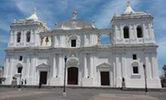The second poorest country in the Western Hemisphere, Nicaragua is a developing nation that faces many economic and political challenges. Crime, while less severe than neighboring countries to the north, continues to affect residents and visitors alike. The national language is Spanish, although many residents of the Caribbean coastal areas also speak English and indigenous languages.
The climate is hot and humid, with the hot dry season running mid-November through mid-May and the less hot rainy season running from mid-May through mid-November. Terrain ranges from the hilly and volcanic to coastal beaches and tropical jungles. Geological faults, along which active volcanoes are situated, run through the country. Tremors are common, and a major earthquake destroyed most of downtown Managua in 1972. Nicaragua presents many opportunities for tourists.
There is a growing tourist infrastructure with comfortable resorts and several large, international chain hotels in Managua catering to business and government clientele as well as tourist travelers. However, support infrastructure is still basic. A good highway network exists along the Pacific littoral and central mountain region, and streets in most cities are in decent condition. However, most rural roads are unpaved. Nicaragua's Atlantic coast is largely roadless. Public transportation is undependable and sometimes unsafe. Emergency services are sporadic, and most hospitals are substandard. Potential tourists may want to obtain information from the National Tourism Institute (INTUR - Spanish only), the governmental agency responsible for developing, regulating and promoting tourism in Nicaragua.
Nicaragua Travel Guide
Top Destinations in Nicaragua

Leon, Nicaragua
León is a city in western Nicaragua. The massive León Cathedral combines baroque and neoclassical architecture. Nearby, the Centro de Arte Fundación Ortiz-... more
